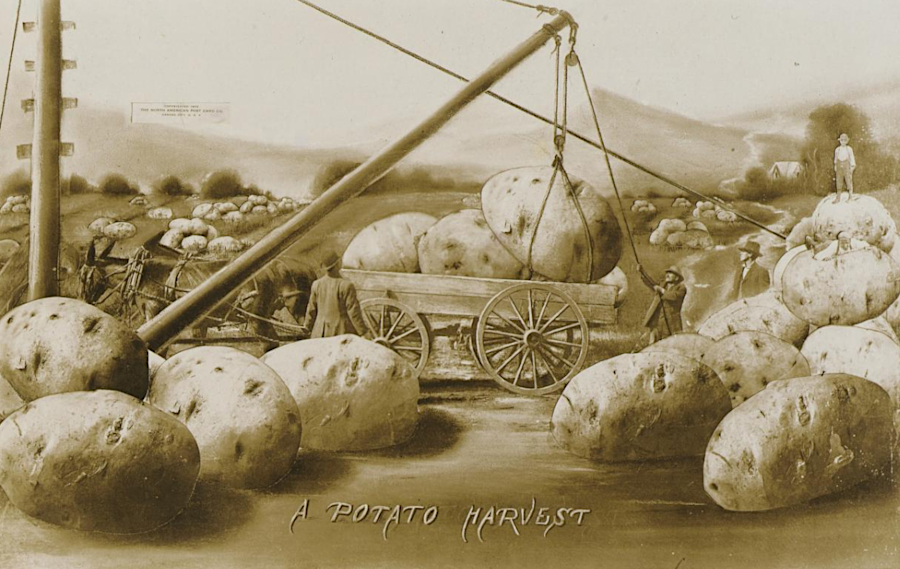
the outsized role of potatoes as a food source is reflected in this imaginary harvest scene
Source: Smithsonian American Art Museum, A Potato Harvest (Gift of Charles Isaacs and Carol Nigro)
The "Irish" potato (Solanum tuberosum) is the #1 vegetable grown in the world. Only grains are more valuable as a food crop.1
The potato was first cultivated in South America, perhaps in Chile. The Spanish discovered the Incas growing a wide variety of potatoes in the Andes and on the Titicaca Plateau in South America. The Incas grew potatoes that were red, pink, yellow, and even a golf-ball sized potato that:2
The potato was described in John Gerard's Herbal of 1597, but the actual origin of the plant was not clarified for over 200 more years. At one time Europeans were under the impression that the potato was discovered in Virginia, and gave credit to Sir Walter Raleigh or Sir Francis Drake. In 1586, Drake brought potatoes home from a voyage in which he had visited the Roanoke Colony in what is now North Carolina, after obtaining supplies in the Caribbean.3
The "Virginia potato" is, like the tomato, a member of the Nightshade family. Both were reputed to be poisonous, like most plants in that family, and were not considered to be a safe food initially.
The cultivated versions in South America were adapted to a wide range of conditions in the mountains. Today, McDonalds buys one type so their french fries are consistent in all stores. Vast acreage of that one variety (Russet Burbanks) is planted in the Dakotas, Idaho, and Colorado - home of the Colorado potato beetle, which is the great scourge of potato growers.
Virginia is a major producer of a different variety, early summer potatoes, and is about the #10 potato producer in the country. Virginia produces over 200,000 pounds of potatoes on about 6,000 acres. Simple math shows the average acre produces 33 pounds of potatoes.4
Virginia's potato cultivation is concentrated on the Eastern Shore. The Virginia Irish Potato and the Virginia Sweet Potato Board are both located in Onley.
The sweet potato (Ipomoea batatas) is a species that prefers a hot, moist climate, and is grown primarily in the tropics. The early summer potatoes are an "Irish" potato (Solanum tuberosum), which thrives in a dry, cool environment. It grew well in the cold climate of Ireland where wheat would not, providing the basic food source for a surge of population growth until the potato blight.
When the Phytophthora infestans fungus arrived in Ireland, it infected nearly all the potato fields between 1845-48. The Irish all planted the same variety (the "Lumper" potato), cloning new crops each year by planting some "eyes" saved from their harvested potatoes, and their massive monoculture of Lumpers was not resistant to the blight. Over 10% of the Irish starved to death during the great potato famine and many others emigrated to America. The loss of the potato as a reliable food source caused Ireland's population to be cut in half.5

the outsized role of potatoes as a food source is reflected in this imaginary harvest scene
Source: Smithsonian American Art Museum, A Potato Harvest (Gift of Charles Isaacs and Carol Nigro)